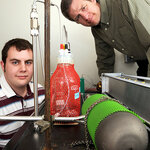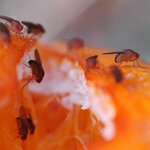Immunology

Artemisinin is the most powerful anti-malaria drug in use today and it commonly obtained by extracting the drug from Artemsisia annua, the sweet wormwood tree.
Synthetic biology can provide a faster and cheaper route, says Jay Keasling, a chemical engineer with joint appointments at Berkeley Lab and UC Berkeley, who led the development of a microbial-based method of producing artemisinin. Fermenting artemisinin via engineered microbes, such as yeast, can be done at far lower costs than , making microbial-based artemisinin a much cheaper but equally effective…

Most college students will admit to searching their couch cushions for extra coins to do laundry. But Jon McKinney's cushion hunt isn't about finding money. He wants to help epidemiologists identify what's triggering diseases like asthma in children, and he's got the backing of the Environmental Protection Agency.
Working with Dr. Glenn Morrison, associate professor of environmental engineering at Missouri University of Science and Technology, the junior is developing the science behind “building forensics,” an emerging field that lies at the outer edge of environmental engineering.
The…

An immune system response that is critical to the first stages of fighting off viruses and harmful bacteria comes from an entirely different direction than most scientists had thought, according to a finding by researchers at the Duke University Medical Center.
Type 1 helper (TH1) T cell immune responses are critical for the control of viruses and certain bacteria. Immunologists have generally believed that TH1 responses are induced by rare immune cells, called dendritic cells. When activated by infection or vaccination, the dendritic cells were thought to move from peripheral tissues…

The detailed structure of a protective 'jacket' that surrounds cells of the Clostridium difficile superbug, and which helps the dangerous pathogen stick to human host cells and tissues, is revealed in part in the 1 March issue of Molecular Microbiology.
Scientists hope that unravelling the secrets of this protective layer's molecular structure might reveal possible targets for new drugs to treat C. difficile infections.
The 'jacket' is a surface layer, or 'S-layer', made of two different proteins, with half a million of each covering every C. difficile cell. The S-layer is believed to…

Researchers at The Scripps Research Institute in La Jolla, California have identified a common Achilles' heel in a wide range of seasonal and pandemic influenza A viruses.
The study found an infection-fighting protein, or human antibody, that neutralizes various influenza A virus subtypes by attaching to these viruses in the same place. This common attachment site provides a constant region of the flu virus for scientists to target in an effort to develop a so-called universal flu vaccine.
Such a vaccine would overcome the annual struggle to make the seasonal flu vaccine match next year's…

Like it or not, your mouth is home to a thriving community of microbial life. More than 600 different species of bacteria reside in this "microbiome," yet everyone hosts a unique set of bugs, and this could have important implications for health and disease. In a new stud, scientists have performed the first global survey of salivary microbes, finding that the oral microbiome of your neighbor is just as different from yours as someone across the globe.
The human body harbors ten times more bacterial cells than human cells – a stunning figure that suggests a likely dynamic between ourselves…

Scientists have identified a small family of lab-made proteins that neutralize a broad range of influenza A viruses, including the H5N1 avian virus, the 1918 pandemic influenza virus and seasonal H1N1 flu viruses.
These human monoclonal antibodies, identical infection-fighting proteins derived from the same cell lineage, also were found to protect mice from illness caused by H5N1 and other influenza A viruses. Because large quantities of monoclonal antibodies can be made relatively quickly, after more testing, these influenza-specific monoclonal antibodies potentially could be used in…

Want to get a lot of money thrown at immunology? Show that sex can not only be exhausting, if you do it right, it can also cause drops in the immune system.
According to a study in Journal of Evolutionary Biology, when fruit flies mate the females' genes are activated to roughly the same extent as when an immune reaction starts. Using a combination of behavioral studies and genomic technology, so-called microarrays, researchers at Uppsala University can show how fruit fly females are affected by mating.
"We monitor how genetic expression is impacted by mating and show that the…

The Rift Valley fever virus is a mosquito-borne African virus that causes fever in humans, inflicting liver damage, blindness and even death on a small percentage of the people it infects. Rift Valley fever also afflicts cattle, goats and sheep, resulting in a nearly 100 percent abortion rate in these animals. Its outbreaks periodically cause economic devastation in parts of Kenya, Somalia, Sudan and Zimbabwe, and bioterrorism experts warn that its introduction to the United States would cripple the North American beef industry.
Researchers at the University of Texas Medical Branch at…

Parents and advocates who believe vaccines cause autism were dealt a double blow this week. On the scientific front, a discredited 1998 study that launched the vaccine-autism debate onto the forefront made headlines, and on the legal front, a special U.S. court ruled that vaccines are not to blame for the disease.The Office of Special Masters in the U.S. Court of Federal Claims oversees cases brought by "persons allegedly suffering injury or death as a result of the administration of certain compulsory childhood vaccines."The court ruled on three cases, saying it "was abundantly clear…